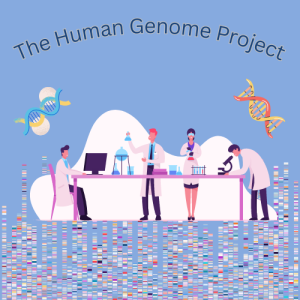Decoding the Key to Life: The Human Genome Project
By Ariane Tsai, C2ST Intern, University of Illinois Urbana-Champaign, Institute for Genomic Biology
It only took four letters to shift scientists’ perspectives on life. For hundreds of years, scientists clung to the belief that proteins were the smallest building blocks of life, and many hypothesized that proteins stored genetic information within them. In 1953, a revelation of unparalleled magnitude shook the scientific community to its core. That year, the double-helical structure of DNA, formed with repeating subunits called nucleotides with four different bases- adenine (A), thymine (T), cytosine(C), or guanine (G), was discovered. The revelation of the existence of DNA transformed our understanding of biology and ushered us into a new era of scientific discovery. Since then, scientists have taken great strides in unraveling the mysteries of life, one of them being the biggest undertaking of the scientific community – the Human Genome Project.

After the discovery of DNA and its structure, many scientists started to develop tools to study DNA. In 1977, Sanger, Maxam, and Gilbert developed a DNA-sequencing technique to map out the exact order of the nucleotides A, C, G, and T in our DNA. The DNA-sequencing technique is now known as “Sanger DNA Sequencing”. With the invention of this tool, a committee of the U.S. National Academy of Science convened in 1988 and mapped out the goal of what came to be the Human Genome Project. The goal was to accomplish the impressive feat of generating the first sequence of the human genome [1]. Now, if you pause and consider the scale of the task, about 3 billion nucleotides make up our entire genome. Imagine mapping each and every one of these letters out!
To tackle this monumental endeavor, researchers from 20 universities worldwide were tasked with this project and formed the International Human Genome Sequencing Consortium. The project was estimated to be completed in 2005; however, by 2000, the Consortium had already produced a draft of 90% of the human genome. Over the following three years, scientists improved the draft to 92% of the human genome, with less than 400 gaps still needing to be added. Since the gaps did not pose any significant contribution to the function of the human body and transcended the sequencing ability at the time, they concluded the project. They declared that the whole human genome had been sequenced [2]. Over the years, the DNA sequencing technique kept advancing. By 2022, the remaining gaps had been filled at the Telomore-to-Telomore (T2T) Consortium [1].
The Human Genome Project has significantly impacted the field of genomics, but it has also made a profound contribution to the scientific community by establishing the “Bermuda Principles.” In 1996, scientists convened in Bermuda and agreed upon a set of principles to promote transparency and rapid data sharing. These principles include: 1) publicly releasing all DNA sequence data within 24 hours, 2) encouraging the sharing of raw sequence data and providing annotation, and 3) prohibiting patents on primary DNA sequence data. These rules have shaped the field of genomics and provided a framework for data sharing in biomedical research globally [3]. Additionally, the project leaders recognized the potential ethical and social concerns of genomics research in the initial stages of the program. Subsequently, they established the Ethical, Legal, and Social Implications (ELSI) Research Program in 1990, ensuring ongoing consideration of these issues as the field expands [1].
The Human Genome Project led us into a new age at the beginning of the 21st century with a complete map of the human DNA sequence. The order of the four letters – A, C, G, and T – has paved the way for remarkable advancements across scientific disciplines. By making the sequence publicly available, scientists made transformative inventions and discoveries within their respective fields. The wealth of information within the human genome has catalyzed many breakthroughs, from personalized medicine to characterizing disease-associated genes. The fundamental human blueprint holds the promise to improve healthcare, unravel the mysteries of genetic disorders, and ultimately enhance our understanding of the intricate tapestry of human life. The impact of the Human Genome Project resonates not only in the scientific community but also in the lives of individuals who stand to benefit from the discoveries and innovations it has inspired.
References:
[1] https://www.genome.gov/about-genomics/educational-resources/fact-sheets/human-genome-project
[2] Alberts B., Bray D., Hopkin. K, Johnson A, Lewis J., Raff, M., Roberts K., Walter P. (2014). Essential Cell Biology 4th Edition. Garland Science.